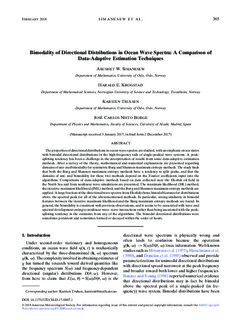| dc.contributor.author | Simanesew, Abushet | |
| dc.contributor.author | Krogstad, Harald E | |
| dc.contributor.author | Trulsen, Karsten | |
| dc.contributor.author | Nieto Borge, Jose Carlos | |
| dc.date.accessioned | 2018-09-06T12:42:38Z | |
| dc.date.available | 2018-09-06T12:42:38Z | |
| dc.date.created | 2018-03-01T21:19:30Z | |
| dc.date.issued | 2018 | |
| dc.identifier.citation | Journal of Atmospheric and Oceanic Technology. 2018, 35 365-384. | nb_NO |
| dc.identifier.issn | 0739-0572 | |
| dc.identifier.uri | http://hdl.handle.net/11250/2561263 | |
| dc.description.abstract | The properties of directional distributions in ocean wave spectra are studied, with an emphasis on sea states with bimodal directional distributions in the high-frequency tails of single-peaked wave systems. A peak-splitting tendency has been a challenge in the interpretation of results from some data-adaptive estimation methods. After a survey of the theory, mathematical and numerical explanations are presented regarding domains of uni- and bimodality for symmetric Burg and Shannon maximum entropy methods. The study finds that both the Burg and Shannon maximum entropy methods have a tendency to split peaks, and that the domains of uni- and bimodality for these two methods depend on the Fourier coefficients input into the algorithms. Comparisons of data-adaptive methods based on data collected near the Ekofisk oil field in the North Sea and from nonlinear wave simulations are presented. The maximum likelihood (ML) method, the iterative maximum likelihood (IML) method, and the Burg and Shannon maximum entropy methods are applied. A large fraction of the directional wave spectra from Ekofisk shows bimodal features for distributions above the spectral peak for all of the abovementioned methods. In particular, strong similarity in bimodal features between the iterative maximum likelihood and the Burg maximum entropy methods are found. In general, the bimodality is consistent with previous observations, and it seems to be associated with wave and spectral development owing to nonlinear wave–wave interactions rather than being associated with the peak-splitting tendency in the estimates from any of the algorithms. The bimodal directional distributions were sometimes persistent and sometimes formed or decayed within the order of hours. | nb_NO |
| dc.language.iso | eng | nb_NO |
| dc.publisher | American Meteorological Society | nb_NO |
| dc.relation.uri | https://journals.ametsoc.org/doi/full/10.1175/JTECH-D-17-0007.1 | |
| dc.title | Bimodality of Directional Distributions in Ocean Wave Spectra: A Comparison of Data-Adaptive Estimation Techniques | nb_NO |
| dc.type | Journal article | nb_NO |
| dc.type | Peer reviewed | nb_NO |
| dc.description.version | publishedVersion | nb_NO |
| dc.source.pagenumber | 365-384 | nb_NO |
| dc.source.volume | 35 | nb_NO |
| dc.source.journal | Journal of Atmospheric and Oceanic Technology | nb_NO |
| dc.identifier.doi | https://doi.org/10.1175/JTECH-D-17-0007.1 | |
| dc.identifier.cristin | 1569935 | |
| dc.relation.project | Norges forskningsråd: 256466 | nb_NO |
| dc.relation.project | Norges forskningsråd: 214556 | nb_NO |
| dc.relation.project | Norges forskningsråd: 225933 | nb_NO |
| dc.description.localcode | © 2018 American Meteorological Society. Locked until 1.3.2019. | nb_NO |
| cristin.unitcode | 194,0,0,0 | |
| cristin.unitname | Norges teknisk-naturvitenskapelige universitet | |
| cristin.ispublished | true | |
| cristin.fulltext | original | |
| cristin.qualitycode | 1 | |
